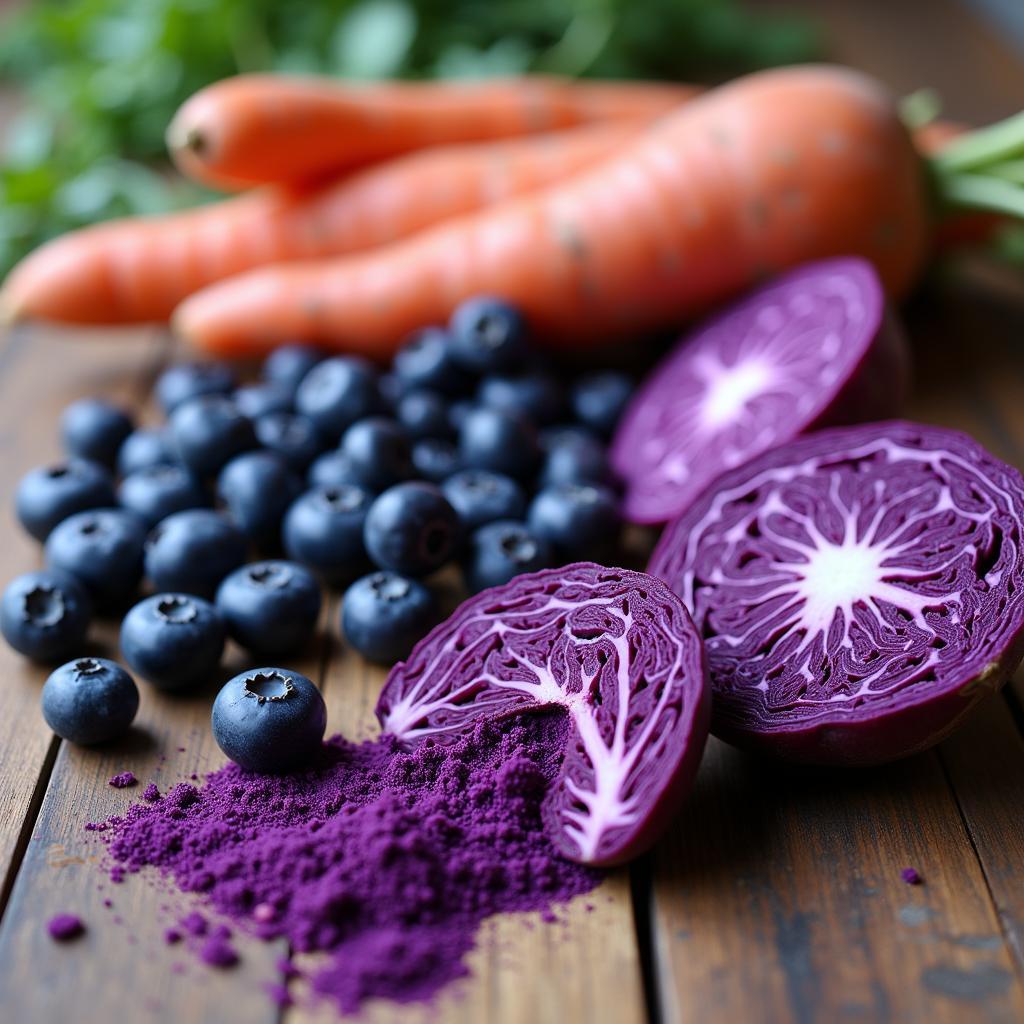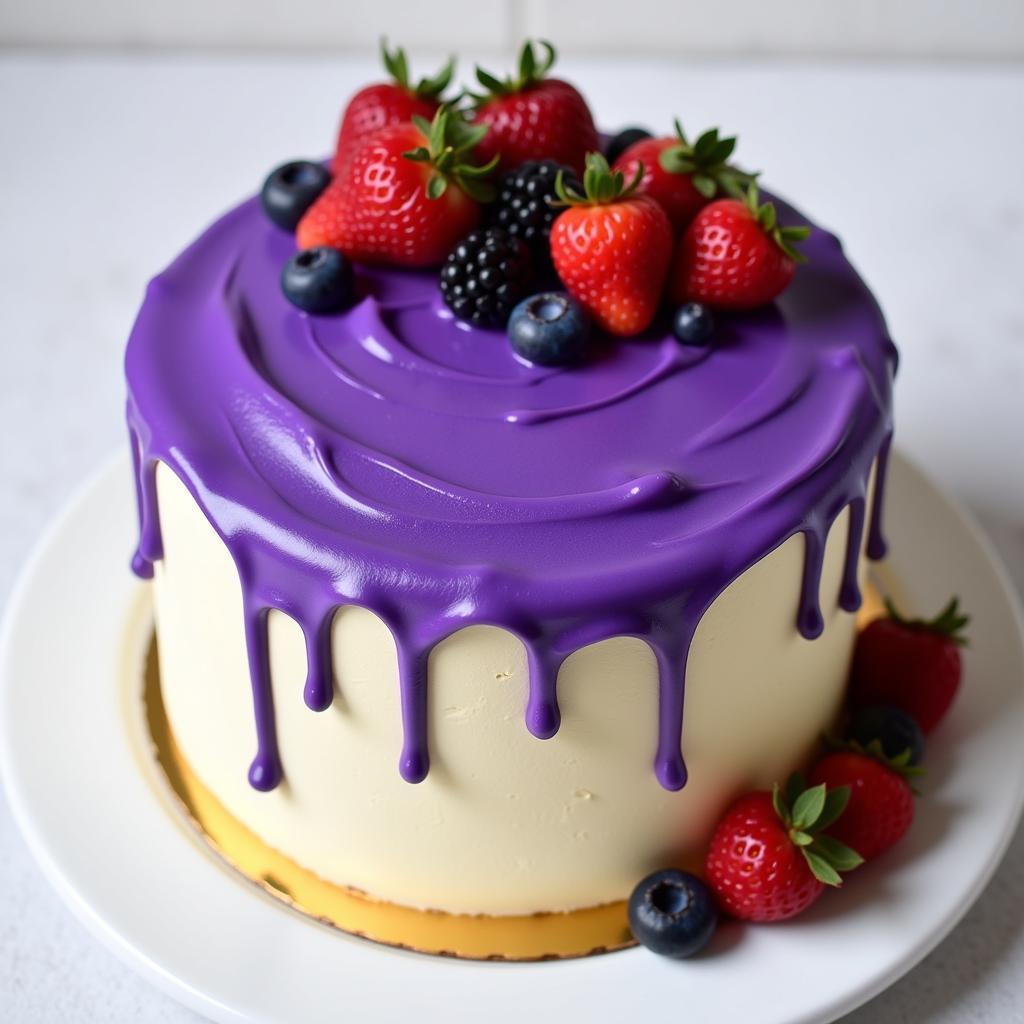Purple food coloring is a popular choice for adding a touch of royalty and vibrancy to various foods and drinks. While synthetic purple food coloring is readily available, many people are looking for natural alternatives due to health concerns. Luckily, nature provides us with an array of ingredients that can create stunning purple hues without artificial additives.
 Natural Purple Food Coloring Ingredients
Natural Purple Food Coloring Ingredients
Unveiling Nature’s Purple Palette
Several fruits and vegetables boast rich purple pigments that can be harnessed for natural food coloring. Let’s explore some of the most potent options:
1. Blueberries: The Antioxidant Powerhouse
These tiny berries are packed with anthocyanins, powerful antioxidants responsible for their deep blue-purple color. To extract the color, simmer blueberries in water, then strain the mixture to obtain a vibrant purple dye.
2. Purple Sweet Potatoes: Earthy and Vibrant
These vibrant root vegetables contain a high concentration of anthocyanins, lending them their beautiful purple hue. Roasting or boiling purple sweet potatoes intensifies their color, making them perfect for creating a concentrated natural food coloring.
 Purple Food Coloring Extraction Process
Purple Food Coloring Extraction Process
3. Red Cabbage: The pH-Sensitive Hue Shifter
Don’t let the name fool you—red cabbage can produce a spectrum of colors, from blue to purple, depending on the pH level. Boiling red cabbage with water creates a blue-purple dye that can be further manipulated with acidic or alkaline ingredients to achieve desired shades.
4. Purple Carrots: A Sweet and Subtle Choice
While not as intensely pigmented as blueberries or purple sweet potatoes, purple carrots offer a milder, sweeter flavor profile. They contain anthocyanins and carotenoids, contributing to their vibrant color.
Creating Your Own Natural Purple Food Coloring
Making your own natural purple food coloring is surprisingly simple and rewarding. Here’s a basic recipe using blueberries:
Ingredients:
- 1 cup fresh or frozen blueberries
- 2 cups water
Instructions:
- Combine blueberries and water in a saucepan.
- Bring the mixture to a boil, then reduce heat and simmer for 15-20 minutes, or until the blueberries have lost most of their color.
- Strain the mixture through a fine-mesh sieve or cheesecloth, discarding the solids.
- Allow the dye to cool completely before using.
 Homemade Purple Frosting with Natural Coloring
Homemade Purple Frosting with Natural Coloring
Tips for Using Natural Purple Food Coloring
- Start with a small amount: Natural food colorings tend to be less concentrated than their synthetic counterparts.
- Adjust for pH: The color of some natural dyes, like red cabbage, can be affected by the pH of the food you’re adding it to.
- Store properly: Store your homemade natural food coloring in an airtight container in the refrigerator for up to a week.
Conclusion: Embrace the Power of Natural Hues
Using natural purple food coloring allows you to create stunning and delicious treats while avoiding artificial ingredients. From the antioxidant-rich blueberries to the versatile red cabbage, nature provides a bounty of options for adding a touch of vibrant color to your culinary creations. So, unleash your inner artist and experiment with these natural wonders to elevate your dishes with the beauty and goodness of nature.
Frequently Asked Questions
1. How long does natural purple food coloring last?
Homemade natural purple food coloring can last up to a week in the refrigerator when stored properly in an airtight container.
2. Can I use frozen fruits and vegetables?
Yes, frozen fruits and vegetables work just as well as fresh ones for making natural food coloring.
3. Does natural purple food coloring affect the taste of my food?
While some natural food colorings, like blueberries, can impart a subtle flavor, others, like purple sweet potatoes, have a milder taste.
4. Can I adjust the shade of purple?
Yes, you can adjust the shade of purple by adding a bit of lemon juice (for a more reddish-purple) or baking soda (for a more bluish-purple).
5. Where can I find more natural food coloring ideas?
Explore our website for a [color chart for food coloring] and discover a world of natural hues to enhance your culinary creations.
Need help finding the perfect shade of [natural purple food coloring]? Contact us at Phone Number: 02437655121, Email: minacones@gmail.com or visit us at 3PGH+8R9, ĐT70A, thôn Trung, Bắc Từ Liêm, Hà Nội, Việt Nam. Our 24/7 customer support team is always here to assist you.
Looking for more vibrant hues? Check out our guides on [neon pink food dye] and [magenta food color] for inspiration!